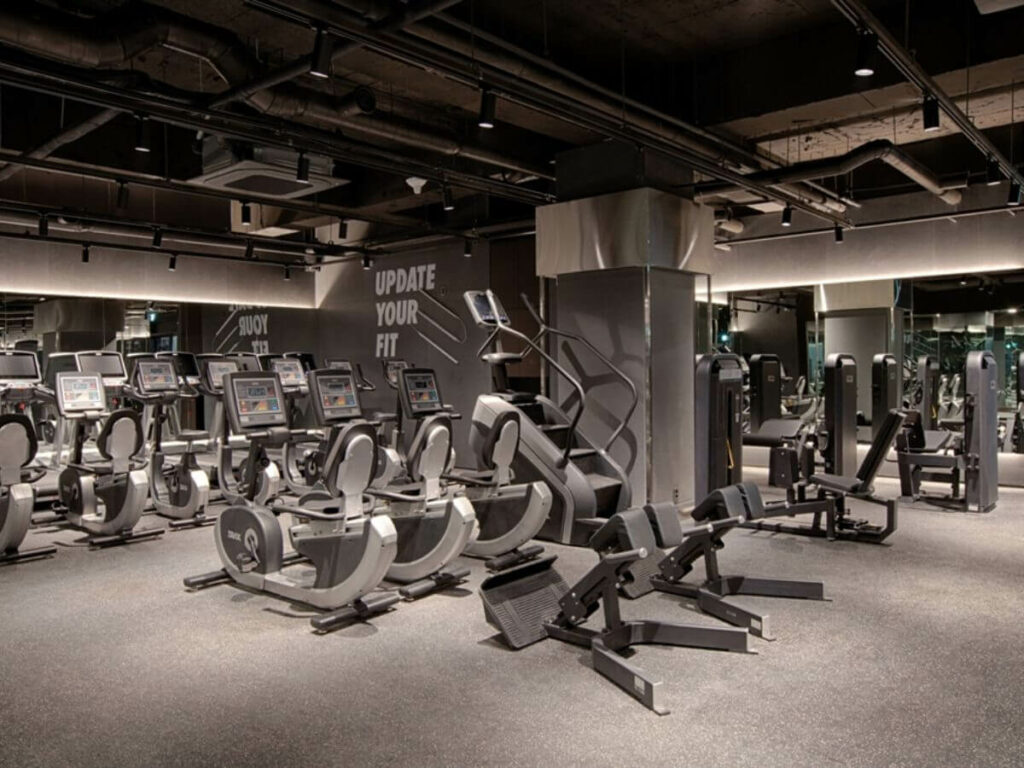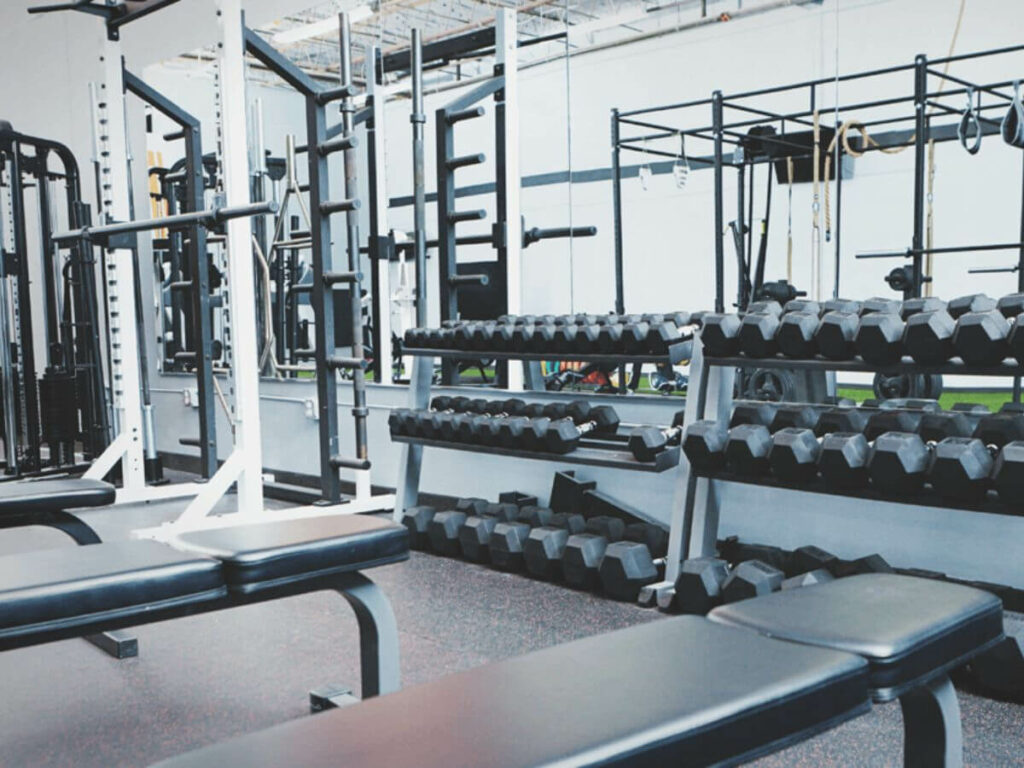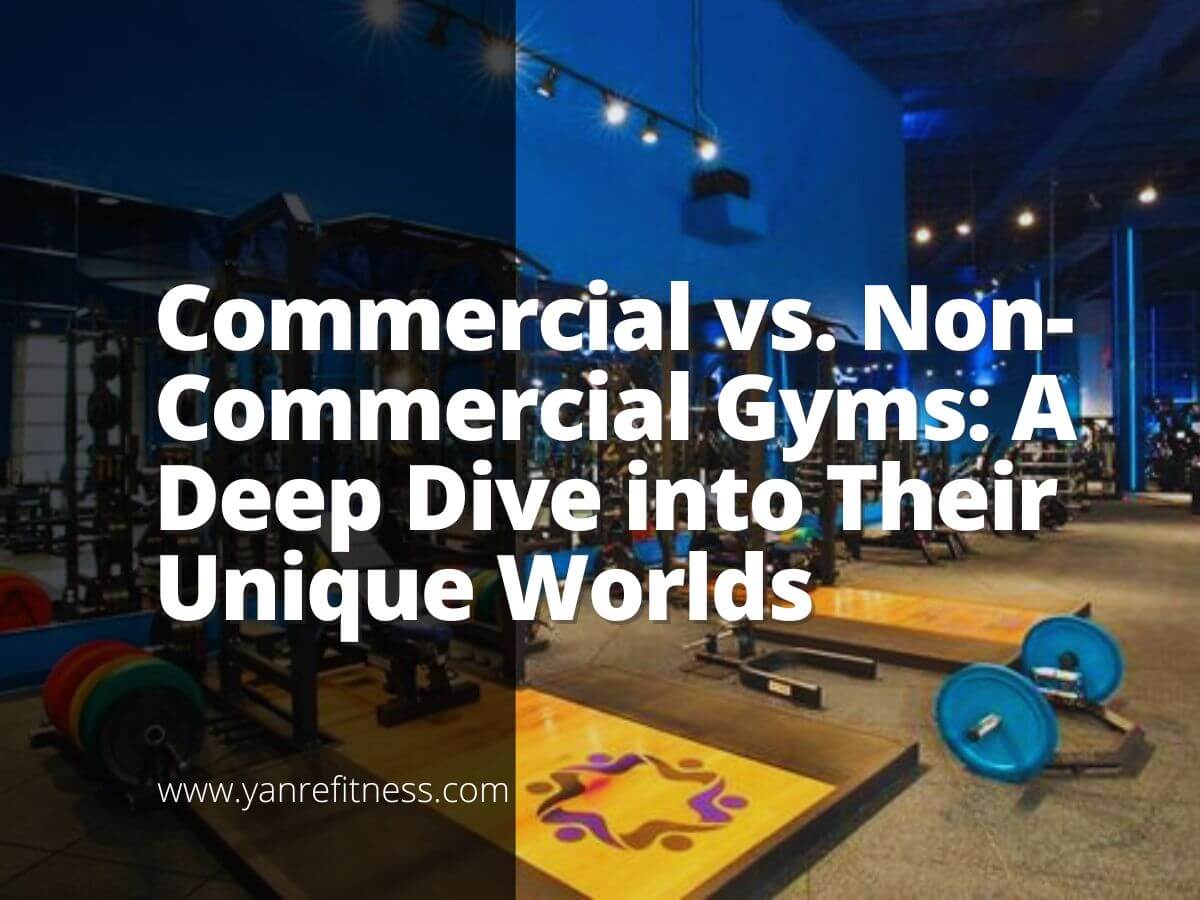Have you ever paused to ponder, what is the difference between commercial and non-commercial gyms?”
As seasoned professionals in the fitness industry, I possess a deep well of experience and insight into the dynamic world of gyms and fitness centers, ensuring you’re receiving informed and reliable advice.
While commercial gyms often provide a more extensive range of equipment and amenities, non-commercial gyms offer a personalized and community-centered environment that is immensely beneficial for some individuals.
The ultimate choice between commercial and non-commercial gyms boils down to your personal fitness goals, preferences, and the atmosphere in which you feel most motivated and comfortable. Each type of gym serves different ‘best for’ cases, catering to diverse needs and expectations.
Keep reading to delve into a comprehensive comparison that illuminates the strengths and weaknesses of each.
Table of Contents
1. Defining Commercial Gym
A commercial gym is essentially a profit-driven business that offers fitness facilities and services to a wide clientele, characterized by extensive space, diverse workout machines, and often multiple nationwide branches for accessibility. The sizable areas accommodate various workouts, equipped with machines ranging from cardio treadmills to strength-training racks.
They function as one-stop fitness solutions.According to LinkedIn, this expansive approach to fitness services aligns with the anticipated growth in the Global Commercial Gym Equipment market from 2023 to 2030, suggesting a trend toward more enhanced and multifaceted gym facilities in the future.

2. Defining Non-Commercial Gyms
Non-commercial gyms, also known as boutique or specialized gyms, cater to niche markets or specific groups of fitness enthusiasts by offering tailored workout experiences and focusing on community-driven or specialized training goals rather than profit. These establishments strive to provide inclusive environments promoting holistic well-being, not just physical fitness.
As noted by resources like 262.run, the dedication to creating environments focused on mastering specific crafts or regimens is evident in these establishments. The intimate and specialized nature of non-commercial gyms allows for a deeper engagement with specific fitness practices and promotes a sense of community and inclusivity among its members.

3. Key Differences Between Commercial and Non-Commercial Gyms
Understanding the key differences between commercial and non-commercial gyms is crucial for gym owners and fitness business wholesalers aiming to make informed decisions about their operations and equipment needs. These distinctions influence everything from the gym’s atmosphere and training support to the cost structure. Below are the subsections that delve into these critical differences:
Atmosphere
- Commercial Gyms: Typically have a polished, high-energy atmosphere aimed at attracting a broad clientele. They often invest in cutting-edge equipment and foster a social, vibrant environment to enhance the client’s fitness experience.
- Non-Commercial Gyms: Often provide a more intimate, community-focused setting. These gyms prioritize creating a supportive atmosphere that may play a crucial role in a client’s commitment to their fitness journey.
Training Support
- Commercial Gyms: Offer a wide range of professional trainers and specialized classes or one-on-one coaching to accommodate different fitness levels and goals, directly contributing to client satisfaction and retention.
- Non-Commercial Gyms: Training support in these settings may be less formal or community-driven, with a focus on creating a collaborative and inclusive learning environment for all members.
Cost Structure
- Commercial Gyms: Operate with a tiered membership model, providing diverse packages and amenities to cater to various fitness needs and budgets. Membership can range from basic access to premium services, including personal training, spa facilities, and nutritional consultations.
- Non-Commercial Gyms: Usually offer simpler, more affordable pricing structures with essential fitness services and fewer luxury amenities, making them accessible to a wider audience.
Membership Perks
- Commercial Gyms: Entice members with various perks like guest passes, free group classes, and discounts on merchandise or personal training sessions. These additional benefits encourage customer loyalty and positive word-of-mouth referrals.
- Non-Commercial Gyms: While they might offer fewer perks, the value in non-commercial gyms often lies in the close-knit community and specialized training they provide, which can also foster loyalty among members.
Facility Specialization
- Commercial Gyms: Offer a wide variety of specialized facilities, from swimming pools and spa centers to saunas, catering to clients desiring a comprehensive fitness experience. These facilities appeal to individuals who enjoy having diverse exercise options within one location.
- Non-Commercial Gyms: Specialize in specific disciplines like martial arts, yoga, or dance. These gyms are ideal for individuals seeking to engage deeply with a particular form of exercise or training in a specialized, focused environment.
4. Pros & Cons of Each Gym Type
Every gym type offers a unique environment tailored to different fitness needs and preferences. When considering commercial and non-commercial gyms, weighing their advantages and disadvantages can provide a clearer perspective for those involved in the fitness sector or those looking for an ideal workout space. Below are the benefits and drawbacks of each gym type:
Commercial Gym
Pros
- Diverse Offerings: These gyms provide an array of equipment and classes suitable for individuals with varied fitness goals. During my visits, I’ve always admired the wide array of options available for different fitness levels and interests. This diversity can keep your workout routine fresh and engaging.
- Amenities: Beyond just workouts, commercial gyms often provide additional amenities like saunas, swimming pools, or relaxation lounges that enhance the overall gym experience. These extra amenities can make your gym time feel like a mini-vacation.
- Consistency: Being part of chains or franchises, there’s an assurance of consistency in services, equipment quality, and ambiance across locations. This makes it easier to transition between different locations without missing a beat in your fitness routine.
- Easy Access: Most commercial gyms have multiple locations, often making it more convenient for you to stick to your workout routine even when traveling. This widespread availability can be a significant benefit for frequent travelers.
- Updated Equipment: Commercial gyms are more likely to invest in the latest fitness technologies and equipment, ensuring a modern and effective workout experience. Access to state-of-the-art equipment can enhance the efficiency and effectiveness of your workouts.
Cons
- Impersonal Environment: Given their scale and clientele, commercial gyms might sometimes lack the personalized touch or community feel. This can make it challenging for some people to feel like they belong or are more than just a membership number.
- Higher Fees: The comprehensive facilities often translate to higher membership fees. For example, added amenities like swimming pools can drive up costs. These added costs can add up quickly, especially if you’re on a budget.
- Overcrowding: Due to their popularity and wide range of offerings, commercial gyms can get extremely crowded, especially during peak hours. This can be frustrating if you have to wait to use specific equipment.
- Additional Costs: Though they may offer a variety of classes and amenities, some may not be included in your base membership fee, requiring additional out-of-pocket expenses. Extra fees for specialized classes or services can make your fitness journey more expensive than initially planned.
Non-Commercial Gym
Pros
- Specialized Training: These gyms excel in offering niche or specialized workouts, ensuring expertise in specific fitness forms. From my interactions, the depth of knowledge in these specializations often stands out. You’re not just getting a general workout; you’re tapping into a well of specialized experience.
- Community Feel: Smaller size and a focus on specific workouts foster a close-knit community atmosphere. This sense of community can be incredibly motivating and can enhance the overall workout experience, encouraging long-term commitment. It’s like having a fitness family that supports you every step of the way.
- Personal Attention: Trainers in these settings often can provide more individualized guidance and feedback. With a lower trainer-to-client ratio, they can closely monitor your form, progress, and adapt your workout plan for optimal results. You’re not just another face in the crowd here.
- Latest Equipment: These gyms often invest in cutting-edge technology and equipment relevant to their specialization. This ensures that you are getting the most up-to-date and effective workout possible, increasing the chances of meeting your fitness goals.
- Flexibility: Smaller gyms are often more flexible with training schedules and program adjustments, tailoring your fitness routine to your lifestyle. This can make it easier for people with irregular schedules to maintain a consistent workout routine.
Cons
- Limited Offerings: By focusing on niche markets, these gyms might not offer as broad a range of workouts or equipment. This could be a drawback for those who seek a more diverse range of exercise options within one location. You might need to go elsewhere for that Zumba class.
- Lack of Additional Amenities: Focused solely on workouts, they might not offer the expansive amenities seen in larger commercial gyms, such as saunas or juice bars. The absence of these perks could be a deciding factor for those who seek a more luxurious gym experience. You won’t find a spa day here.
- Higher Costs: Given their specialized nature and personal attention, memberships at these gyms can be on the pricier side. The cost could be a barrier for those on a budget, making it less accessible for everyone.
- Restricted Availability: These gyms often have limited hours due to their smaller size and specialized focus. This could pose a challenge for those who prefer working out during off-peak hours or have unpredictable schedules.
5. 3 Tips to Consider When Choosing the Right Gym for Your Needs
Choosing the right gym is a decision that goes beyond the equipment and aesthetics. It’s about finding a place where one’s fitness goals align, where motivation thrives, and where every visit becomes a productive session. Below are the pivotal factors that can guide an individual or business professional in making an informed gym choice:
#1 Unique Fitness Goals
Every individual has unique fitness goals. It’s vital to choose a gym that aligns with these objectives. From my experience, aligning your environment with your intentions makes a world of difference. If you’re into specialized training, then a non-commercial gym might be a better fit. However, if you’re looking for variety, commercial gyms could offer broader options.
#2 Ambiance and Environment
The ambiance of a gym can profoundly shape an individual’s motivation and dedication to their fitness routine. While some are invigorated by a dynamic and vibrant atmosphere, others find their rhythm in serene and intimate settings. Elements such as lighting, musical backdrop, and the chosen color palette can subtly yet significantly influence the overall mood and energy during a workout.
| Factor | Description |
| Lighting | Ensure well-lit spaces with a balance of natural and artificial light. Adjustable lighting for different areas can set the mood and energy levels. |
| Music | Curate playlists with energizing music to motivate members. Offer headphone-friendly zones for those who prefer their own tunes. |
| Temperature Control | Maintain a comfortable temperature year-round. Proper ventilation is vital to prevent stuffiness and maintain air quality. |
| Cleanliness | Implement strict cleanliness protocols, including regular sanitization of equipment and high-touch surfaces. A clean gym is a safe gym. |
| Layout & Spacing | Optimize the gym layout for efficient traffic flow and adequate spacing between equipment. Create designated zones for specific workouts. |
| Décor | Choose motivating décor that aligns with fitness goals. Inspiring quotes, fitness-related artwork, and well-maintained aesthetics can enhance the gym’s appeal. |
| Equipment Quality | Invest in high-quality, well-maintained equipment that’s ergonomically designed. Faulty or outdated machines can deter members. |
| Community Feel | Foster a sense of community through group classes, events, and social spaces. A strong community encourages member engagement. |
| Privacy | Provide options for those who prefer privacy during workouts, such as enclosed areas or separate training rooms. |
| Staff Interaction | Train staff to be approachable, knowledgeable, and helpful. Friendly interactions can create a welcoming atmosphere. |
| Safety Measures | Implement safety measures like first aid stations, emergency exits, and clear signage. Members should feel secure while working out. |
#3 Flexible Membership Plans
Gym memberships can range from affordable to premium, depending on the services and facilities they offer. It’s essential to find a gym that offers value for money within one’s budget. Additionally, consider if the gym provides flexible membership plans, allowing you to opt for short-term or long-term commitments.
#4 Trained Staff and Instructors
Having well-trained and certified staff can significantly enhance your gym experience. They can guide you through efficient workout routines, correct your form, and even provide nutritional advice. In my opinion, a knowledgeable trainer can be the difference between a good workout and a great one. Always look out for gyms that prioritize staff training and certifications.
#5 Location and Accessibility
The gym’s location can play a crucial role in how often you’ll be able to make it to your workout sessions. Proximity to your home or workplace can encourage consistent attendance, while a distant location might make it easier to skip a day. Evaluate the convenience of the location, parking facilities, and public transportation options before making a decision.
Conclusion
The distinctions between commercial and noncommercial gyms significantly impact the experiences and options available to fitness enthusiasts. Choosing between commercial and noncommercial gyms ultimately depends on an individual’s personal fitness goals, preferences, and values.
By understanding the unique characteristics and advantages of each type of gym, individuals can better navigate their options and select a fitness environment that best supports their health and wellness journey.
Related articles:








